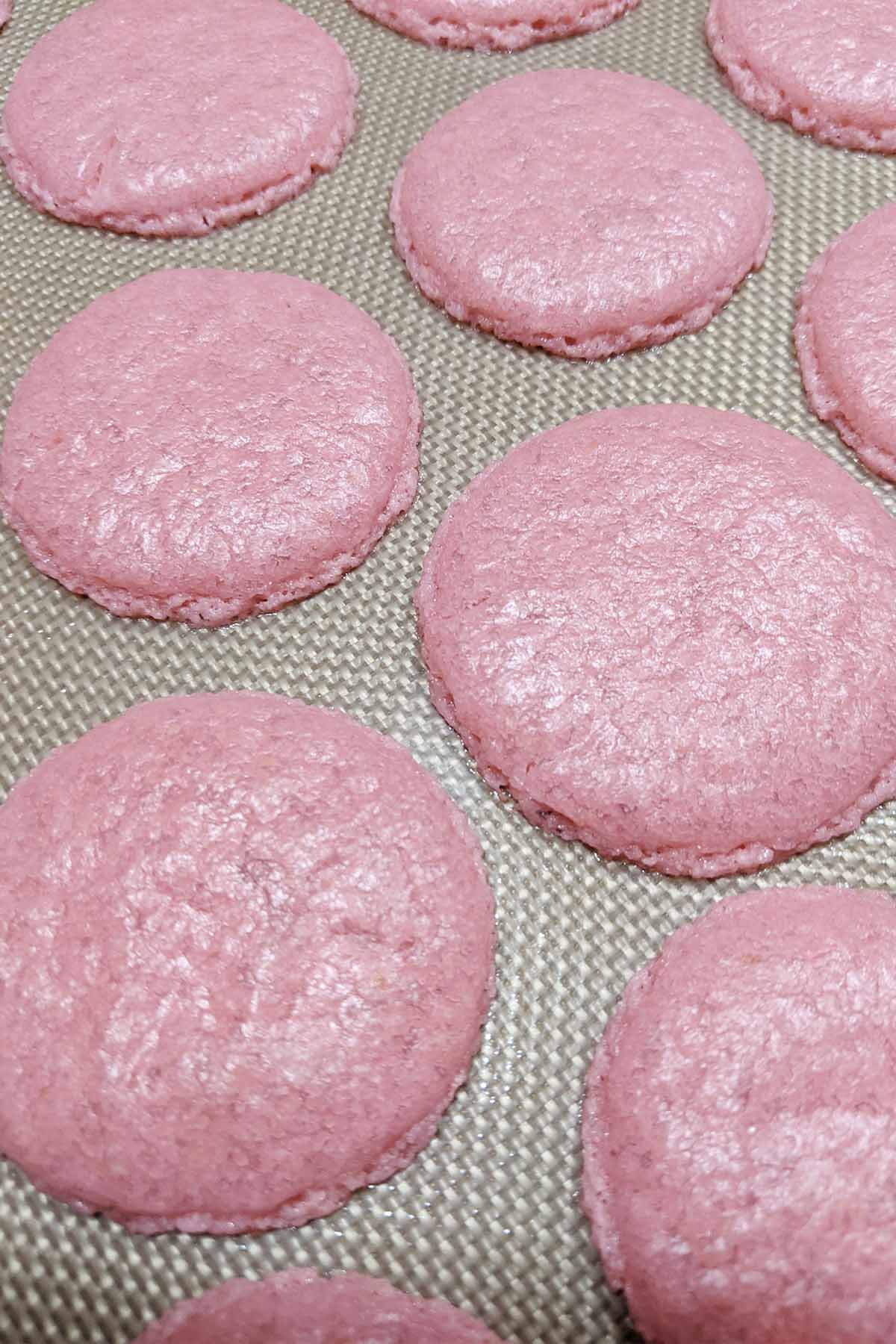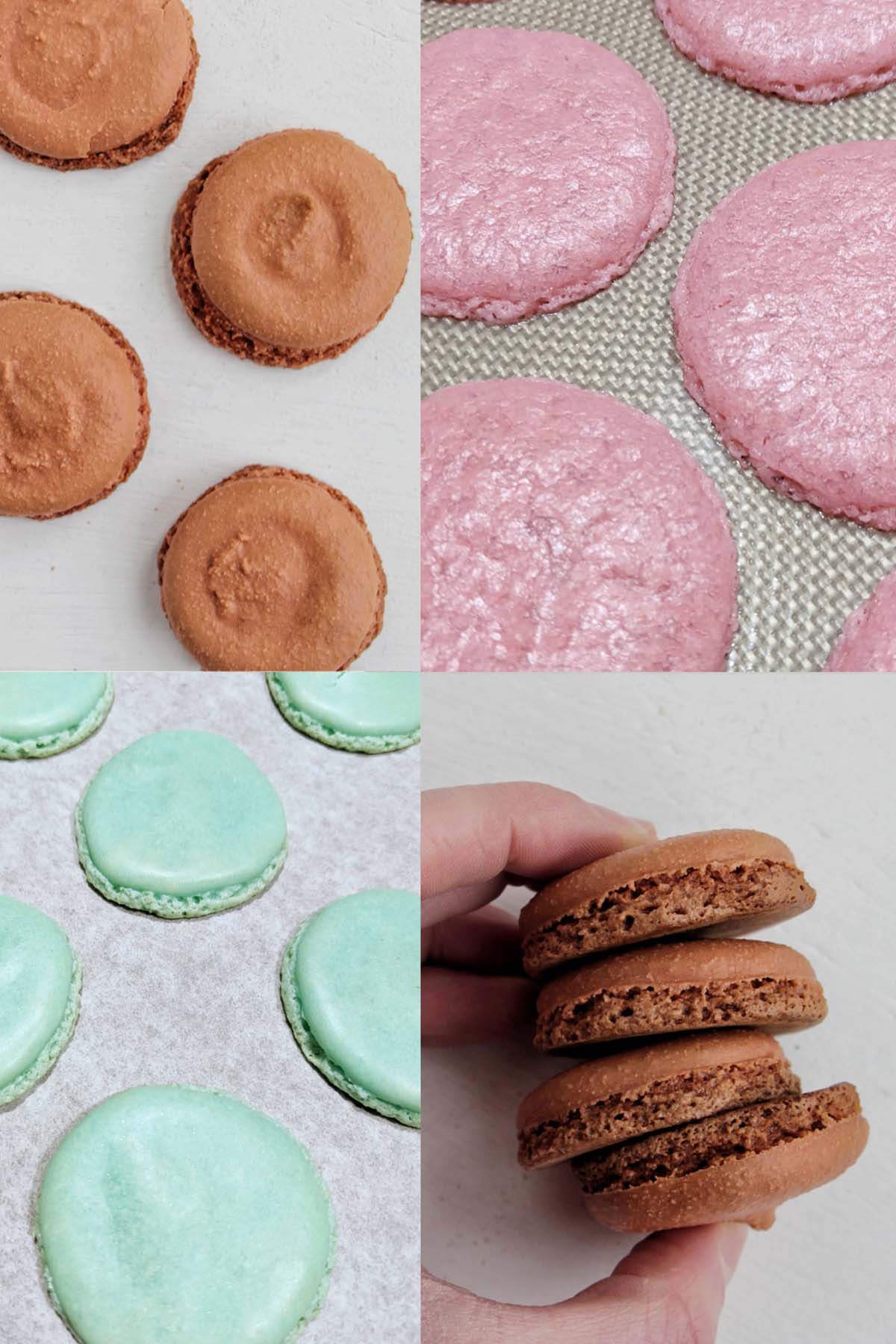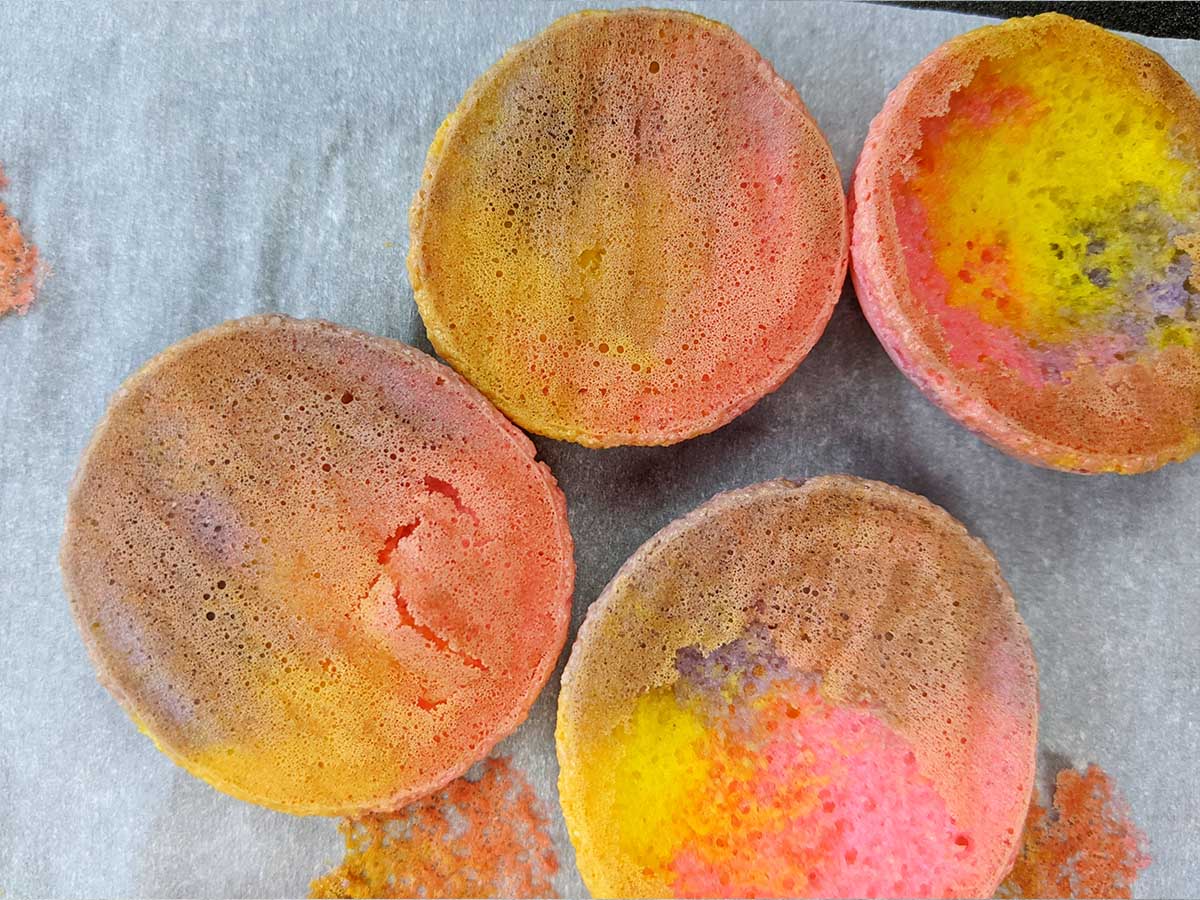15 Tips for Making & Troubleshooting Macarons
Learn the best tips for making macarons and troubleshooting the ones that don’t turn out correctly. This guide will teach you the important techniques for improving your homemade macarons.
Why are my macarons flat?
Here are a few common causes of flat macarons:
1. The oven is too hot or too cold: If your oven is too low, you’ll notice that the macarons won’t properly rise. Not only will they be flatter than a normal macaron, but the feet will be short (under 2 millimeters), and the tops will likely be wrinkly or indented.
On the other hand, if your oven is too hot, the shells will be flat because proper feet will not form. The macarons will bake too quickly on the outside, leaving a moist interior that doesn’t properly rise.
2. You under whipped the meringue: You didn’t whip your meringue to stiff peaks. Under whipped meringue won’t be strong enough to properly rise in the oven. It can lead to flat, wrinkled, or weak macaron tops.
3. You over macaronaged your batter: Another common issue that results in flat macarons is over macaronaged batter. Macaronage is a term that refers to folding the dry macaron ingredients (almond flour and confectioners’ sugar) into the meringue. This process smooths the mixture and helps the macarons bake with proper structure.
When you over macaronage, you’ll notice the batter is very thin and easily falls off the spatula. You’ll also notice that the batter spreads really easily when piped. It might even fall out of your piping bag when transferring from one circle to the next on your piping template.
If you’re still having trouble, check out my troubleshooting guide for flat macarons.
Why are my macarons cracked?
1. Your oven is too hot: Most likely, cracked macarons are related to oven temperatures that are too hot. To fix this issue, you’ll first want to purchase an oven thermometer.
This inexpensive cooking tool will allow you to see if your oven is heating to the temperature you’re setting it to. Oftentimes, home ovens are known for heating hotter or colder than you set the temperature to.
2. Your meringue is under or over whipped: Both under-whipped and over-whipped meringue can result in cracked shells. This is because the meringue needs to have the proper structure in order to rise in the oven.
Weak meringue will not be strong enough to withstand the heat of the oven when baked, causing a cracked top. Alternatively, meringue that has been over-whipped won’t have enough air incorporated to properly expand in the oven.
3. You didn’t rest your macarons long enough: It’s important to allow your macarons to rest on the counter until they’ve formed a skin.
Typically, you’ll need to allow the shells to rest for about 45 – 60+ minutes on the counter until a skin has formed on top. If you live in a humid climate, this may take up to 90+ minutes.
4. You have air bubbles in the macarons: Did you put your macarons in the oven without banging them on the counter? Oftentimes, air bubbles are trapped in the macaron batter. Air bubbles occur naturally in the batter during the macaronage and piping process.
In order to avoid cracked macaron shells, you need to release and pop these air bubbles; otherwise, they will burst in the oven and ruin the shells.
If you’re still having trouble, check out my troubleshooting guide for cracked macarons.

Why are my macarons wrinkled?
Here are a few common causes of wrinkled macaron shells:
1. Your oven temperature is too low: To remedy this, you’ll first need to purchase an oven thermometer and place it in the center rack of your oven to double-check the temperature reading before baking the macarons.
Next, you’ll need to play around with your temperature settings. I usually recommend heating your oven to 300°F (150°C) and adjusting from there. Pipe a set of 4 – 6 macarons on a baking sheet and test just a few macarons at a time (so you don’t ruin a whole batch).
2. You over or under whipped the meringue: One of the most important techniques to learn, especially when making macarons, is how to whip egg whites to stiff peaks.
Egg whites that are under whipped or over whipped can result in wrinkled shells, weak tops, and macarons that will not properly rise.
3. You over macaronaged the batter: Another common issue related to wrinkly macaron shells is over macaronaging.
Macaronage is a term that refers to folding the dry macaron ingredients (almond flour and confectioners’ sugar) into the meringue. This process smooths the mixture and helps the macarons bake with proper structure.
To properly macaronage, you should fold the batter until it reaches a lava-like consistency. You can test this by lifting your spatula and seeing if the batter drops almost like lava. Once it drops off the spatula, the batter that was dripped should fade back into the batter within 10 – 15 seconds.
If you’re still having trouble, check out my troubleshooting guide for wrinkly macarons.
Why are my macaron shells soft?
Here are a few common causes of weak/soft macaron shells:
1. Your meringue is under whipped. French meringue needs to be properly beaten in order to form a strong macaron. Make sure that you’re beating the meringue to stiff peaks.
To test the meringue stiffness, pull the whisk out. A stiff peak should stand straight up (no curl at the tip). Signs that you’re ready to test the stiffness include seeing lines left from the beaters in your eggs. In addition, the meringue starts to almost ball up inside the whisk attachment. You’ll also know it’s ready because you can fully flip the bowl over and nothing moves or falls out.
2. The macaron shells are underbaked. If you don’t give your macaron shells enough time to bake in the oven, a sturdy outside will never develop. Make sure to check that the macarons are done before pulling them out of the oven. If you touch the shell and it wiggles or is still sticky/wet, you know they need to bake longer.

Why are my macaron feet messed up?
Here are a few common causes of small feet, no feet, or feet that have ruffled/spread too far:
1. Your oven temperature is too high or too low: Work on dialing in your oven temperature. You may have to try a few different oven temperatures in order to find the perfect temperature for your home oven. You can read more about my experiments with oven temperature if you’re curious to learn more.
2. You didn’t rest the macarons long enough: Typically, you’ll need to allow the shells to rest for about 45 – 60+ minutes on the counter until a skin has formed on top. If you live in a humid climate, this may take up to 90+ minutes.
3. You over or under macaronaged the batter: If you’ve over macaronaged your batter, it will be too thin and runny. This will cause your macarons to fall flat with small feet or even no feet. An overworked batter can also cause the macarons to spread out horizontally, rather than rising up vertically.
If you’re still having trouble, check out my troubleshooting guide for macaron feet.
Why are my macarons browned?
Here are a few common causes of browned macarons:
1. Your oven is too hot: To fix this, make sure you have an oven thermometer to measure the exact temperature of your oven, then place it in the center rack of your oven for a proper reading. Try lowering the oven temperature by 5°F (3°C) at a time.
2. The macarons are baking too long: Turn on your oven light (but don’t open the oven door) to keep an eye on the macarons while they’re baking. You’ll know the macarons are done backing because the feet and the edge of the macarons feel firm when you gently touch them.

Why are my macarons hollow?
Here are a few common causes of hollow macaron shells:
This is the last troubleshooting problem you should worry about. Before perfecting your macarons so they don’t have hollows, make sure all the other properties are correct:
1. The meringue is over and under whipped: In order to prevent hollows, you need the perfect consistency of meringue before starting the macaronage process. Oftentimes, adding in acid, like cream of tartar, can help stabilize your meringue and allow more time for the air to get incorporated.
2. The batter was over or under macaronaged: The macaronage stage, which refers to working your batter to the proper consistency, is a technique that takes a while to master. If you’ve worked the batter to a lava-like consistency and you’re still getting hollow shells, try working it a tad less.
3. Your oven temperature is too high or low: Oven temperature plays a big role in hollow macarons. Unfortunately, due to the capabilities of home conventional ovens, you have to test and play around with the temperature to get your macaron shells perfect. Most recipes suggest baking macarons anywhere from 275°F (135°C) – 325°F (163°C). Test these temperature ranges out with your home oven and an oven thermometer to see what works best.
If you’re still having trouble, check out my troubleshooting guide for hollow macarons.
















![Toni Kroos là ai? [ sự thật về tiểu sử đầy đủ Toni Kroos ]](https://evbn.org/wp-content/uploads/New-Project-6635-1671934592.jpg)


